Unit 2 It's Show Time! Lesson 8 Marco Polo and the Silk Road课件(共24张PPT) 2023-2024学年冀教版英语七年级下册
文档属性
| 名称 | Unit 2 It's Show Time! Lesson 8 Marco Polo and the Silk Road课件(共24张PPT) 2023-2024学年冀教版英语七年级下册 | 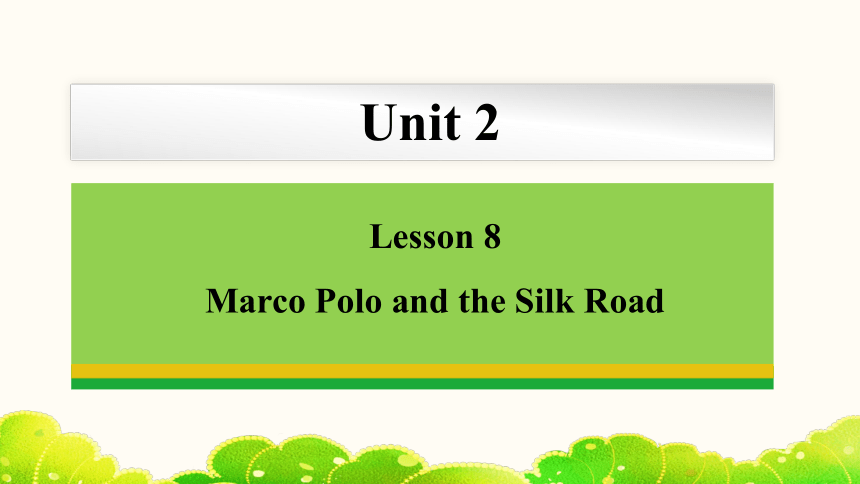 | |
| 格式 | pptx | ||
| 文件大小 | 82.8MB | ||
| 资源类型 | 教案 | ||
| 版本资源 | 冀教版 | ||
| 科目 | 英语 | ||
| 更新时间 | 2024-01-03 09:11:34 | ||
图片预览

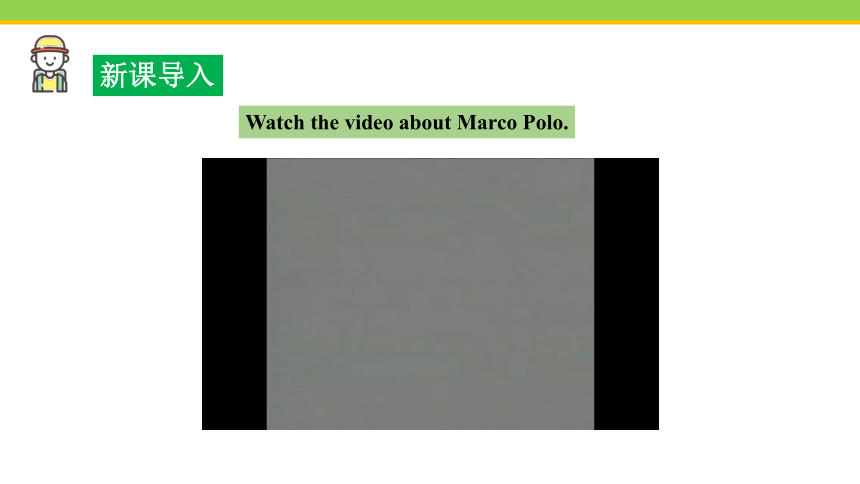
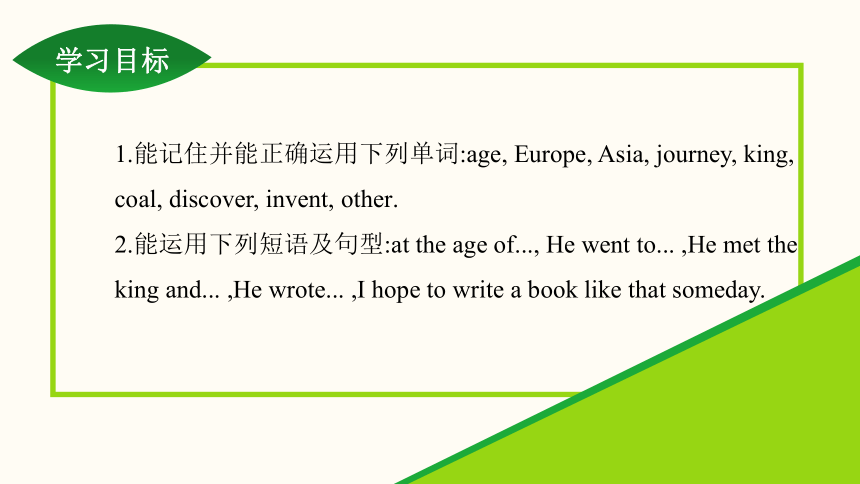
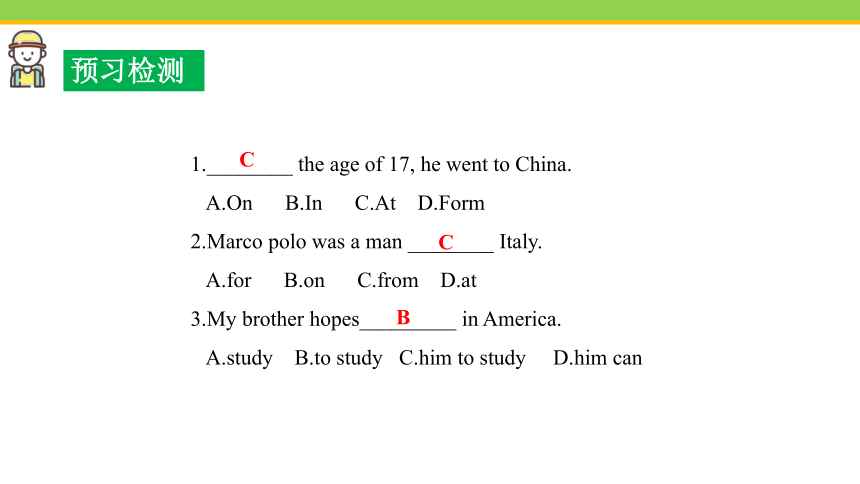
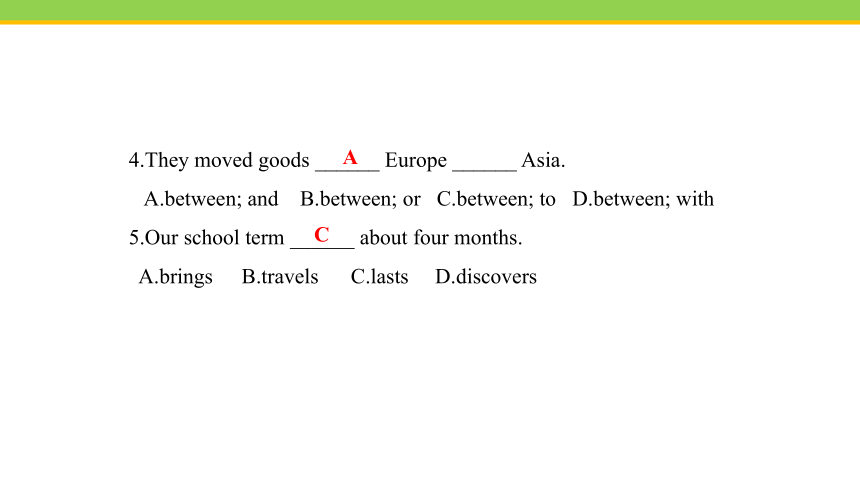
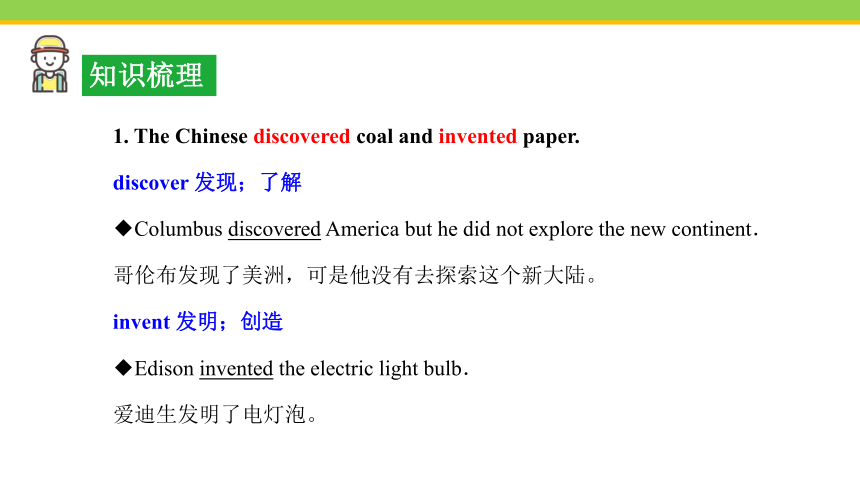


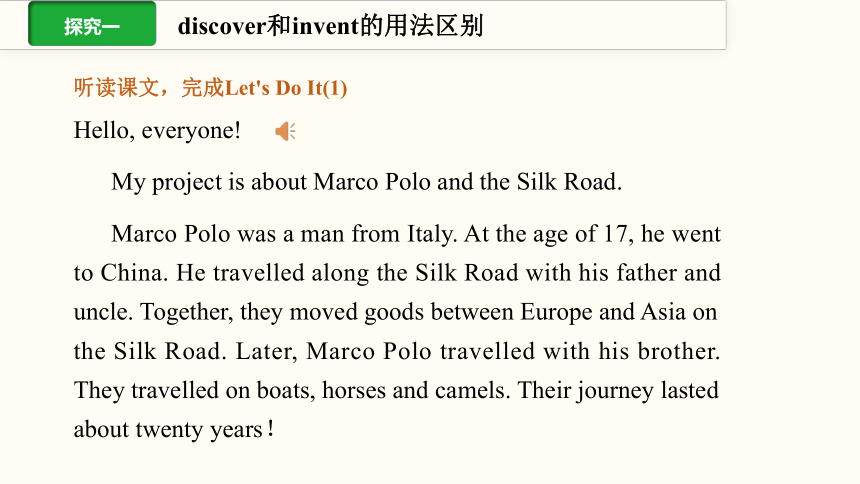
文档简介
(共24张PPT)
Unit 2
Lesson 8
Marco Polo and the Silk Road
新课导入
Watch the video about Marco Polo.
1.能记住并能正确运用下列单词:age, Europe, Asia, journey, king, coal, discover, invent, other.
2.能运用下列短语及句型:at the age of..., He went to... ,He met the king and... ,He wrote... ,I hope to write a book like that someday.
预习检测
1.________ the age of 17, he went to China.
A.On B.In C.At D.Form
2.Marco polo was a man ________ Italy.
A.for B.on C.from D.at
3.My brother hopes_________ in America.
A.study B.to study C.him to study D.him can
C
C
B
4.They moved goods ______ Europe ______ Asia.
A.between; and B.between; or C.between; to D.between; with
5.Our school term ______ about four months.
A.brings B.travels C.lasts D.discovers
A
C
知识梳理
1. The Chinese discovered coal and invented paper.
discover 发现;了解
◆Columbus discovered America but he did not explore the new continent.
哥伦布发现了美洲,可是他没有去探索这个新大陆。
invent 发明;创造
◆Edison invented the electric light bulb.
爱迪生发明了电灯泡。
2. These things were new to Marco Polo.
be new to…表示“对……陌生,不熟悉,没做(听)过”。
◆This kind of work is new to me.
这种工作对我来说很陌生。
◆As a beginner, everything is very new to him.
他刚起步,对一切都很生疏。
3. I hope to write a book like that someday.
hope to do sth. 表示“希望做某事”。
◆We all hope to go to college.
我们都希望她会喜欢这些花。
discover和invent的用法区别
Hello, everyone!
My project is about Marco Polo and the Silk Road.
Marco Polo was a man from Italy. At the age of 17, he went to China. He travelled along the Silk Road with his father and uncle. Together, they moved goods between Europe and Asia on the Silk Road. Later, Marco Polo travelled with his brother. They travelled on boats, horses and camels. Their journey lasted about twenty years!
听读课文,完成Let's Do It(1)
In 1275, Marco Polo travelled to Beijing. He met the king and worked for him for 17 years. During those years, Marco Polo learned about coal and paper. The Chinese discovered coal and invented paper. These things were new to Marco Polo. He brought some coal and paper back to Italy with him. He also brought back a lot of silk, tea and other goods.
Marco Polo wrote a famous book about his travels to China. I hope to write a book like that someday.
Thank you.
By:Jenny
Date:March 25
1 Listen and tick the correct answers.
Let's Do It !
1.At the age of ________,Marco Polo went to China.
□twenty □seventeen □sixteen
2.Marco Polo and his father moved goods between ________
on the Silk Road.
□America and Asia □Europe and Asia
□Europe and America
3.Marco Polo learned about ______ in China.
□tea and paper □coal and silk □coal and paper
√
√
√
Let's learn
discover
invent
“发现;了解”,表示发现原来就有的物品。
发明;创造 (是指创造前所未有的事物)
Divide these things into two groups according to whether it existed before or not.
coal
paper
gas
Edison discovered the electric light bulb.
Who invented coal
Columbus discovered America but he did not explore the new continent.
The Wright brothers discovered the plane.
判断下列句子是否正确
3 Fill in the blanks with the correct forms of the
words in the box.
hope coal journey discover goods
1.People sell their ________ at the market.
2.It’s cold in the house. Put some ________ on the fire.
3.After the long ________, Marco Polo arrived in Beijing at last.
4.He didn’t do well this time. But he ________ to do better next
time.
5.I walked around my city and I ___________ some beautiful
places.
goods
coal
journey
hopes
discovered
Let's Do It !
活动小结
discover意为____________,表示发现__________的物品。比如:_________________________等。
invent意为____________,表示指创造__________的事物。比如:___________________________等
原来就有
前所未有
发现;了解
发明;创造
煤,天然气,岛屿或大陆
指南针,纸张,飞机,蒸汽机
规则动词过去式的变化规则
一般在动词末尾加-ed.
例如:play — _______
以不发音的字母e结尾的动词在词尾加-d.
例如:live — _________
末尾是一个元音字母加一个辅音字母的重读闭音节词,先双写这个辅音字母,再加-ed.
例如:stop —___________
以“辅音字母+y”结尾的词,先变y 为i, 再加-ed.
例如:study — ___________
played
lived
stopped
studied
practice
arrive __________
enjoy __________
move __________
worry __________
plan __________
need __________
smile __________
carry __________
climb __________
try __________
arrived
enjoyed
moved
worried
planned
needed
smiled
carried
climbed
tried
1.What country did Marco Polo come from?
2.How did he and his brother travel
3.How long did his journey last
4.When did he travel to Beijing
5.What did he bring back to his home country
Italy.
They travelled on boats, horses and camels.
It lasted about twenty years.
In 1275.
He brought back some coal,paper,a lot of silk,
tea and other goods.
2 Read the lesson and answer the questions.
Let's Do It !
Group work
What do you know about Marco Polo Find more information about him and present it to the class.
Where was he from
He was from Italy.
Task tips:
1.Where was he from
2.How old was he when he came to China
3.What did he do in China
4.What amazing things did he learn about in China
5.How long did he stay in China?
活动小结
规则动词过去式的变化规则
1.一般在动词末尾加_______.
2.以不发音的字母e结尾的动词在词尾加________.
3.末尾是一个元音字母加一个辅音字母的重读闭音节词,先_____这个辅音字母,再加________.
4.以“辅音字母+y”结尾的词,先变___ 为____, 再加______.
ed
d
ed
y
i
ed
双写
一. 根据句意及首字母提示完成单词
1.You can see beautiful flowers a _________ in the school.
2.It's impolite (不礼貌的)to make j_______ on the old.
3.There will be a new silk road between E _______ and Asia.
4.—What’s your p _________ about
—It’s about some places of interest in Canada.
5.Could you please put more c ____ on the fire (火)
当堂检测
nywhere
okes
urope
roject
oal
二. 根据汉语完成句子
1.那次会议持续了三个多小时。
That meeting________ ________ more than three hours.
2.李刚五岁开始画画。
________ ________ ________ ________ five, Li Gang started to draw.
3.我想了解更多中国的历史和文化。
I want to________ ________ ________ Chinese history and culture.
4.格林一家上个月到北京旅游了。
The Greens__________ ________ Beijing last month.
5.我姐姐将会给我带回一个礼物。
My sister________ ________ a present ________ for me.
lasted for
At the age of
learn more about
travelled to
will bring back
Unit 2
Lesson 8
1.be new to…表示“对……陌生,不熟悉,没做(听)过”
2.hope to do sth. 表示“希望做某事”
3.discover 发现;了解(指初次看见本来已存在但以前未被发现的事物 )
invent 发明;创造 (是指创造前所未有的事物)
规则动词过去式的变化规则
1.一般在动词末尾加ed.
2.以不发音的字母e结尾的动词在词尾加d.
3.末尾是一个元音字母加一个辅音字母的重读闭音节词,先双写这个辅音字母,再加ed.
4.以“辅音字母+y”结尾的词,先变y为i, 再加ed.
Unit 2
Lesson 8
Marco Polo and the Silk Road
新课导入
Watch the video about Marco Polo.
1.能记住并能正确运用下列单词:age, Europe, Asia, journey, king, coal, discover, invent, other.
2.能运用下列短语及句型:at the age of..., He went to... ,He met the king and... ,He wrote... ,I hope to write a book like that someday.
预习检测
1.________ the age of 17, he went to China.
A.On B.In C.At D.Form
2.Marco polo was a man ________ Italy.
A.for B.on C.from D.at
3.My brother hopes_________ in America.
A.study B.to study C.him to study D.him can
C
C
B
4.They moved goods ______ Europe ______ Asia.
A.between; and B.between; or C.between; to D.between; with
5.Our school term ______ about four months.
A.brings B.travels C.lasts D.discovers
A
C
知识梳理
1. The Chinese discovered coal and invented paper.
discover 发现;了解
◆Columbus discovered America but he did not explore the new continent.
哥伦布发现了美洲,可是他没有去探索这个新大陆。
invent 发明;创造
◆Edison invented the electric light bulb.
爱迪生发明了电灯泡。
2. These things were new to Marco Polo.
be new to…表示“对……陌生,不熟悉,没做(听)过”。
◆This kind of work is new to me.
这种工作对我来说很陌生。
◆As a beginner, everything is very new to him.
他刚起步,对一切都很生疏。
3. I hope to write a book like that someday.
hope to do sth. 表示“希望做某事”。
◆We all hope to go to college.
我们都希望她会喜欢这些花。
discover和invent的用法区别
Hello, everyone!
My project is about Marco Polo and the Silk Road.
Marco Polo was a man from Italy. At the age of 17, he went to China. He travelled along the Silk Road with his father and uncle. Together, they moved goods between Europe and Asia on the Silk Road. Later, Marco Polo travelled with his brother. They travelled on boats, horses and camels. Their journey lasted about twenty years!
听读课文,完成Let's Do It(1)
In 1275, Marco Polo travelled to Beijing. He met the king and worked for him for 17 years. During those years, Marco Polo learned about coal and paper. The Chinese discovered coal and invented paper. These things were new to Marco Polo. He brought some coal and paper back to Italy with him. He also brought back a lot of silk, tea and other goods.
Marco Polo wrote a famous book about his travels to China. I hope to write a book like that someday.
Thank you.
By:Jenny
Date:March 25
1 Listen and tick the correct answers.
Let's Do It !
1.At the age of ________,Marco Polo went to China.
□twenty □seventeen □sixteen
2.Marco Polo and his father moved goods between ________
on the Silk Road.
□America and Asia □Europe and Asia
□Europe and America
3.Marco Polo learned about ______ in China.
□tea and paper □coal and silk □coal and paper
√
√
√
Let's learn
discover
invent
“发现;了解”,表示发现原来就有的物品。
发明;创造 (是指创造前所未有的事物)
Divide these things into two groups according to whether it existed before or not.
coal
paper
gas
Edison discovered the electric light bulb.
Who invented coal
Columbus discovered America but he did not explore the new continent.
The Wright brothers discovered the plane.
判断下列句子是否正确
3 Fill in the blanks with the correct forms of the
words in the box.
hope coal journey discover goods
1.People sell their ________ at the market.
2.It’s cold in the house. Put some ________ on the fire.
3.After the long ________, Marco Polo arrived in Beijing at last.
4.He didn’t do well this time. But he ________ to do better next
time.
5.I walked around my city and I ___________ some beautiful
places.
goods
coal
journey
hopes
discovered
Let's Do It !
活动小结
discover意为____________,表示发现__________的物品。比如:_________________________等。
invent意为____________,表示指创造__________的事物。比如:___________________________等
原来就有
前所未有
发现;了解
发明;创造
煤,天然气,岛屿或大陆
指南针,纸张,飞机,蒸汽机
规则动词过去式的变化规则
一般在动词末尾加-ed.
例如:play — _______
以不发音的字母e结尾的动词在词尾加-d.
例如:live — _________
末尾是一个元音字母加一个辅音字母的重读闭音节词,先双写这个辅音字母,再加-ed.
例如:stop —___________
以“辅音字母+y”结尾的词,先变y 为i, 再加-ed.
例如:study — ___________
played
lived
stopped
studied
practice
arrive __________
enjoy __________
move __________
worry __________
plan __________
need __________
smile __________
carry __________
climb __________
try __________
arrived
enjoyed
moved
worried
planned
needed
smiled
carried
climbed
tried
1.What country did Marco Polo come from?
2.How did he and his brother travel
3.How long did his journey last
4.When did he travel to Beijing
5.What did he bring back to his home country
Italy.
They travelled on boats, horses and camels.
It lasted about twenty years.
In 1275.
He brought back some coal,paper,a lot of silk,
tea and other goods.
2 Read the lesson and answer the questions.
Let's Do It !
Group work
What do you know about Marco Polo Find more information about him and present it to the class.
Where was he from
He was from Italy.
Task tips:
1.Where was he from
2.How old was he when he came to China
3.What did he do in China
4.What amazing things did he learn about in China
5.How long did he stay in China?
活动小结
规则动词过去式的变化规则
1.一般在动词末尾加_______.
2.以不发音的字母e结尾的动词在词尾加________.
3.末尾是一个元音字母加一个辅音字母的重读闭音节词,先_____这个辅音字母,再加________.
4.以“辅音字母+y”结尾的词,先变___ 为____, 再加______.
ed
d
ed
y
i
ed
双写
一. 根据句意及首字母提示完成单词
1.You can see beautiful flowers a _________ in the school.
2.It's impolite (不礼貌的)to make j_______ on the old.
3.There will be a new silk road between E _______ and Asia.
4.—What’s your p _________ about
—It’s about some places of interest in Canada.
5.Could you please put more c ____ on the fire (火)
当堂检测
nywhere
okes
urope
roject
oal
二. 根据汉语完成句子
1.那次会议持续了三个多小时。
That meeting________ ________ more than three hours.
2.李刚五岁开始画画。
________ ________ ________ ________ five, Li Gang started to draw.
3.我想了解更多中国的历史和文化。
I want to________ ________ ________ Chinese history and culture.
4.格林一家上个月到北京旅游了。
The Greens__________ ________ Beijing last month.
5.我姐姐将会给我带回一个礼物。
My sister________ ________ a present ________ for me.
lasted for
At the age of
learn more about
travelled to
will bring back
Unit 2
Lesson 8
1.be new to…表示“对……陌生,不熟悉,没做(听)过”
2.hope to do sth. 表示“希望做某事”
3.discover 发现;了解(指初次看见本来已存在但以前未被发现的事物 )
invent 发明;创造 (是指创造前所未有的事物)
规则动词过去式的变化规则
1.一般在动词末尾加ed.
2.以不发音的字母e结尾的动词在词尾加d.
3.末尾是一个元音字母加一个辅音字母的重读闭音节词,先双写这个辅音字母,再加ed.
4.以“辅音字母+y”结尾的词,先变y为i, 再加ed.
同课章节目录
- Unit 1 A Trip to the Silk Road
- Lesson 1 A Trip to China
- Lesson 2 Meet You in Beijing
- Lesson 3 A Visit to Xi'an
- Lesson 4 A Visit to Lanzhou
- Lesson 5 Another Stop along the Silk Road
- Lesson 6 Jenny's Diary
- Unit 2 It's Show Time!
- Lesson 7 What's Your Project about?
- Lesson 8 Marco Polo and the Silk Road
- Lesson 9 Danny's School Project
- Lesson 10 Music and Dance
- Lesson 11 Food in China
- Lesson 12 A Blog about the Silk Road
- Unit 3 School Life
- Lesson 13 How Is School Going?
- Lesson 14 Jenny's School Life
- Lesson 15 Making a Difference
- Lesson 16 We Are with You!
- Lesson 17 School Science Fai
- Lesson 18 Teaching in China
- Unit 4 After-School Activities
- Lesson 19 A Dinner Date
- Lesson 20 Join Our Club!
- Lesson 21 What Is Your Club Type?
- Lesson 22 Big Plans for the Weekend
- Lesson 23 A Weekend with Grandma
- Lesson 24 How was Your Weekend?
- Unit 5 I Love Learning English!
- Lesson 25 A Phone Friend
- Lesson 26 Online Phone Calls
- Lesson 27 Amazing English
- Lesson 28 How Do I Learn English?
- Lesson 29 A Door to the World
- Lesson 30 Writing an E-mail in English
- Unit 6 Seasons
- Lesson 31 What Strange Weather!
- Lesson 32 I Can't Wait for Winter!
- Lesson 33 Kim's Favourite Season
- Lesson 34 Steven's Report
- Lesson 35 Surfing in Sydney
- Lesson 36 Spring in China
- Unit 7 Sports and Good Health
- Lesson 37 You Are What You Eat!
- Lesson 38 Stay Healthy!
- Lesson 39 Danny's Report
- Lesson 40 Move Your Body
- Lesson 41 Were People Healthy Then?
- Lesson 42 Know Yourself
- Unit 8 Summer Holiday Is Coming!
- Lesson 43 Have a Good Summer!
- Lesson 44 Volunteering in Summe
- Lesson 45 Baseball Season
- Lesson 46 Get Ready for Summer Holiday!
- Lesson 47 Summer Plans
- Lesson 48 Li Ming's Summer Holiday
